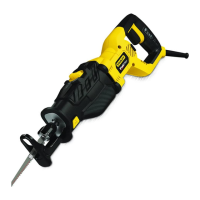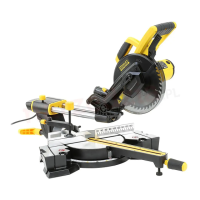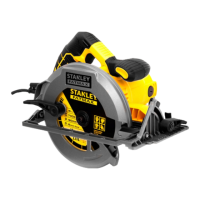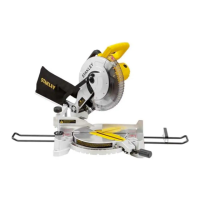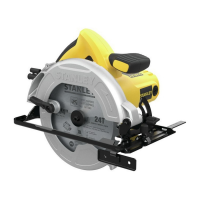9
ENGLISH
(Original instructions)
Further safety instructions for all saws
Kickback causes and related warnings
u kickbackisasuddenreactiontoapinched,boundor
misaligned saw blade, causing an uncontrolled saw to
liftupandoutoftheworkpiecetowardtheoperator;
t whenthebladeispinchedorboundtightlybythekerf
closing down, the blade stalls and the motor reaction
drivestheunitrapidlybacktowardtheoperator;
t if the blade becomes twisted or misaligned in the cut,
theteethatthebackedgeofthebladecandigintothe
top surface of the wood causing the blade to climb out
ofthekerfandjumpbacktowardtheoperator.
Kickbackistheresultoftoolmisuseand/orincorrectoperating
proceduresorconditionsandcanbeavoidedbytakingproper
precautionsasgivenbelow.
u Maintain a rm grip with both hands on the saw and
position your arms to resist kickback forces. Position
your body to either side of the blade, but not in line
with the blade.Kickbackcouldcausethesawtojump
backwards,butkickbackforcescanbecontrolledbythe
operator,ifproperprecautionsaretaken.
u When blade is binding, or when interrupting a cut
for any reason, release the trigger and hold the saw
motionless in the material until the blade comes to a
complete stop. Never attempt to remove the saw from
the work or pull the saw backward while the blade is
in motion or kickback may occur.Investigateandtake
correctiveactionstoeliminatethecauseofbladebinding.
u When restarting a saw in the workpiece, centre the
saw blade in the kerf and check that saw teeth are
not engaged into the material.Ifsawbladeisbinding,it
maywalkuporkickbackfromtheworkpieceasthesawis
restarted.
u Support large panels to minimise the risk of blade
pinching and kickback. Large panels tend to sag under
theirownweight.Supportsmustbeplacedunderthe
panel on both sides, near the line of cut and near the edge
ofthepanel.
u Do not use dull or damaged blades. Unsharpened or
improperlysetbladesproducenarrowkerfcausingexces-
sivefriction,bladebindingandkickback.
u Blade depth and bevel adjusting locking levers
must be tight and secure before making cut. Ifblade
adjustmentshiftswhilecutting,itmaycausebindingand
kickback.
u Use extra caution when sawing into existing walls or
other blind areas.Theprotrudingblademaycutobjects
thatcancausekickback.
Lower guard function
u Check guard for proper closing before each use. Do
not operate the saw if guard does not move freely
and enclose the blade instantly. Never clamp or tie
the guard so that the blade is exposed.Ifsawisac-
cidentallydropped,guardmaybebent.Checktomake
sure that guard moves freely and does not touch the blade
oranyotherpart,inallanglesanddepthsofcut.
u Check the operation of the lower guard spring. If the
guard and the spring are not operating properly, they
must be serviced before use. Lower guard may operate
sluggishly due to damaged parts, gummy deposits, or a
build-upofdebris.
u The lower guard may be retracted manually only for
special cuts sucha as "plunge cuts" and "compound
cuts". Raise the lower guard by the retracting handle
and as soon as the blade enters the material, the
lower guard must be released. For all other sawing, the
lowerguardshouldoperateautomatically.
u Always observe that the lower guard is covering the
blade before placing the saw down on bench or oor.
Anunprotected,coastingbladewillcausethesawtowalk
backwards,cuttingwhateverisinitspath.Beawareof
thetimeittakesforthebladetostopaftertheswitchis
released.
Saw blades
u Do not use blades of larger or smaller diameter than
recommended.Fortheproperbladeratingrefertothe
technicaldata.Useonlythebladesspeciedinthis
manual,complyingwithEN847-1.
u Warning! Neveruseabrasivewheels.
Safety of others
u This tool can be used by children aged from 8 years and
above and persons with reduced physical, sensory or
mentalcapabilitiesorlackofexperienceandknowledgeif
they have been given supervision or instruction concern-
ing use of the appliance in a safe way and understand the
hazardsinvolved.
u Childrenshallnotplaywiththetool.Cleaninganduser
maintenance shall not be made by children without super-
vision.
Residual risks
Additionalresidualrisksmayarisewhenusingthetoolwhich
maynotbeincludedintheenclosedsafetywarnings.These
riskscanarisefrommisuse,prolongeduseetc.
Even with the application of the relevant safety regulations
and the implementation of safety devices, certain residual
riskscannotbeavoided.Theseinclude:
u Injuriescausedbytouchinganyrotating/movingparts.
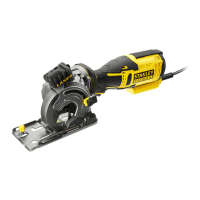
